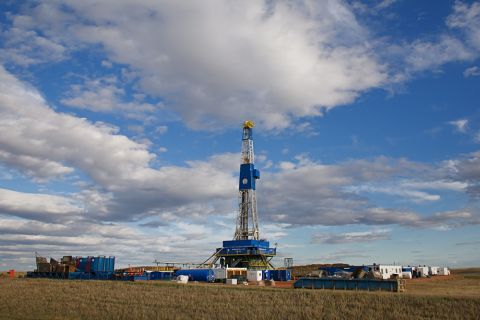
At Hart Energy’s 50th Anniversary Hall of Fame Awards on Dec. 5, (left to right) Dan Pickering, chief investment officer of Pickering Energy Partners, Harold Hamm, founder and executive chairman of Continental Resources, Tom Petrie, chairman of Petrie Partners, and Chris Wright, chairman and CEO of Liberty Energy. (Source: Hart Energy)
Directional drilling and fracking advances reinvigorated a floundering U.S. oil and gas industry and moved American energy onto the global stage. Experts say the world will need a lot more U.S. oil and gas for decades to come.
Speaking at Hart Energy’s 50th Anniversary Hall of Fame Awards on Dec. 5, Harold Hamm, North Dakota Bakken pioneer and founder and executive chairman of Continental Resources, called horizontal drilling the biggest turning point in U.S. energy over the past half-century.
“It’s horizontal drilling that really gave us the ability to access what I call ‘Generation 2’ rock,” Hamm said.
RELATED
See Hart Energy’s Inaugural Hall of Fame Recipients Here
Chris Wright, chairman and CEO of oilfield services firm Liberty Energy, credited fracking for helping deliver a more affordable supply of natural gas and crude oil domestically and internationally.
He cited George Mitchell’s pioneering efforts in the Barnett Shale for unlocking commercial shale gas production.
“Certainly I, and probably most, had no idea how transformative this would be to the world,” Wright said.
Horizontal drilling and fracking fueled a massive increase in U.S. oil and gas production. Crude oil production alone nearly doubled from 2009 to 2015. But a ban on nearly all exports of U.S. crude volumes prevented American producers from accessing global markets.
The lifting of the decades-old crude oil export ban by the Obama administration in 2015—at the behest of Hamm and other energy industry heavyweights—allowed U.S. crude to flow around the globe.
“How can you go in 15 years from the biggest net importer to the biggest net exporter?” Wright asked. “It’s not just the economics, it’s the geopolitical transformation of power where United States’ position in the world has just risen dramatically.”
RELATED
Hart Energy at 50: How We’ve Grown
Meeting global demand
Despite the growth of renewable energy resources, the world will continue to need oil and gas from the U.S. for many years—and probably many decades—to come, Hamm said.
“We need to make sure that we’ve got the fuel for the future, and we do have it,” Hamm said. “We think we can see 50 years of oil usage ahead of us in the foreseeable future, and over 50 to 100 years of natural gas.”
While demand for American oil and gas will continue to rise in the near future, Hamm admitted that U.S. E&Ps also have to do their part in cleaning up and lowering their own emissions.
“A lot of us are involved in different things to do that—carbon capture and underground sequestration certainly can be our forte,” Hamm said. “We’re good at all those things whether it be pipelining, handling pressure, working with underground reservoirs, all that stuff.”
Wright, who worked in the nuclear and solar energy industries before entering the oil and gas space, is also on board with the energy transition.
But he takes umbrage with the moniker “energy transition” itself.
“Where we are today, we can’t even see the start of an energy transition,” Wright said. “A transition implies something is replacing something—we can’t see that today.”
Based on stated policies by nations around the world, the International Energy Agency estimates global demand for coal, oil and natural gas could peak before 2030.
Provisions in the Inflation Reduction Act are also fueling new domestic renewables investment, including in wind, solar and clean hydrogen.
At the same time, industry experts and analysts also see strong demand for fossil fuels like natural gas and LNG continuing into the 2040s and 2050s.
Click here to learn more about Hart Energy’s 50th anniversary and to see the inaugural Hall of Fame recipients.
Recommended Reading
Marketed: Wylease AFE Asset Packages in Johnson County, Wyoming
2024-04-29 - Wylease LLC has retained EnergyNet for the sale of three Niobrara Shale AFE (authorization for expenditure) packages in Johnson County, Wyoming.
M&A Spotlight Shifts from Permian to Bakken, Marcellus
2024-04-29 - Potential deals-in-waiting include the Bakken’s Grayson Mill Energy, EQT's remaining non-operated Marcellus portfolio and some Shell and BP assets in the Haynesville, Rystad said.
Chevron CEO: Permian, D-J Basin Production Fuels US Output Growth
2024-04-29 - Chevron continued to prioritize Permian Basin investment for new production and is seeing D-J Basin growth after closing its $6.3 billion acquisition of PDC Energy last year, CEO Mike Wirth said.
E&P Highlights: April 29, 2024
2024-04-29 - Here’s a roundup of the latest E&P headlines, including a new contract award and drilling technology.
C-NLOPB Issues Call for Bids in Eastern Newfoundland
2024-04-29 - Winners of the Call for Bids No. NL24-CFB01 will be selected based on the highest total of money the bidder commits to spend on exploration of a parcel during the first six years of a nine-year license.




